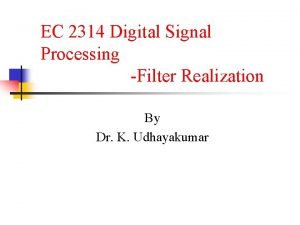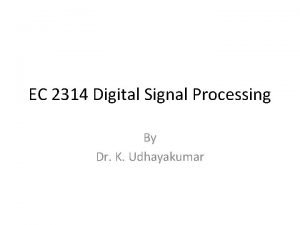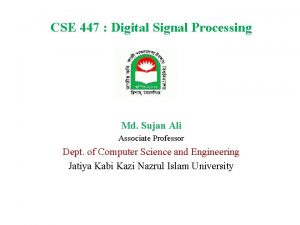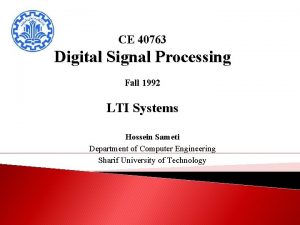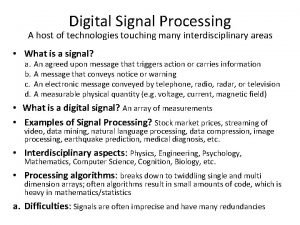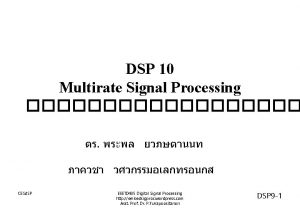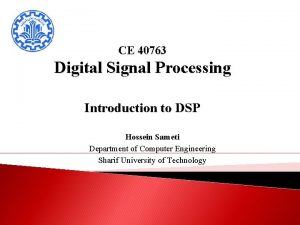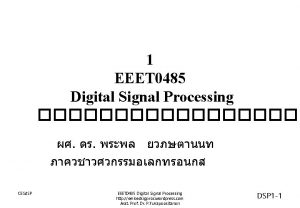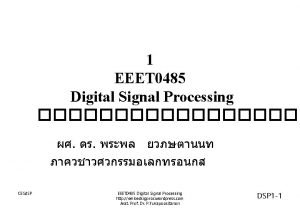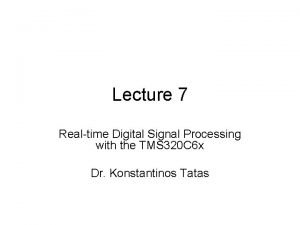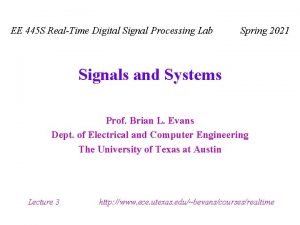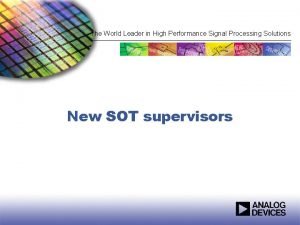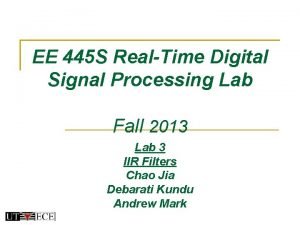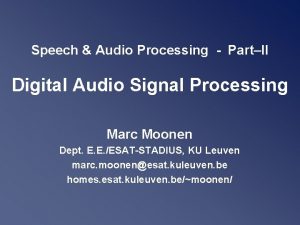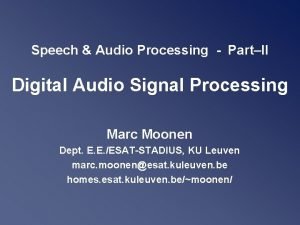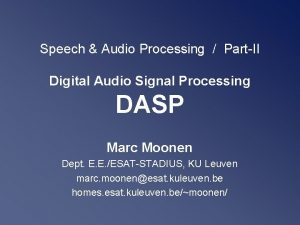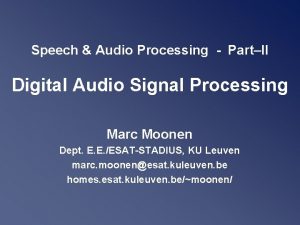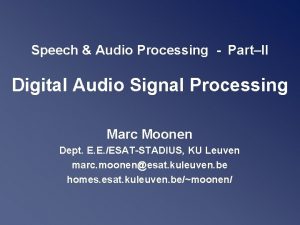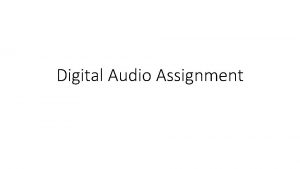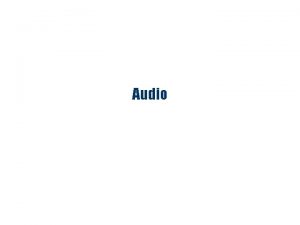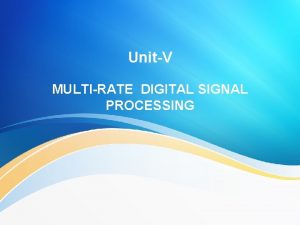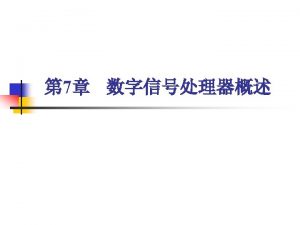Digital Signal Processing Applications Unit VI Audio Processing
















- Slides: 16

Digital Signal Processing Applications (Unit VI) Audio Processing Image Formation and Display Prof. H. D. Sonawane, Computer Department, B. V. C. O. E. &R. I. , Nashik 1

Audio Processing Involved Sound presentation to human listeners: 1. High fidelity sound reproductions (Audio on CDs) 2. Voice Telecommunications (Telephone Networks) 3. Synthesis speech (Computers Generate and recognize human voice patterns) 2

Interface • While all these fields have their different goals and problems they are linked by common interface, Human ear 3

Human Hearing ØPlace Principle Contained within the cochlea is the basilar membrane, the supporting structure for about 12, 000 sensory cells forming the cochlear nerve. The basilar membrane is stiffest near the oval window, and becomes more flexible toward the opposite end, allowing it to act as a frequency spectrum analyzer. When exposed to a high frequency signal, the basilar membrane resonates where it is stiff, resulting in the excitation of nerve cells close to the oval window. Likewise, low frequency sounds excite nerve cells at the far end of the basilar membrane. This makes specific fibers in the cochlear nerve respond to specific frequencies. This organization is called the place principle, and is preserved throughout the auditory pathway into the brain. ØVolly Principle Another information encoding scheme is also used in human hearing, called the volley principle. Nerve cells transmit information by generating brief electrical pulses called action potentials. A nerve cell on the basilar membrane can encode audio information by producing an action potential in response to each cycle of the vibration. For example, a 200 hertz sound wave can be represented by a neuron producing 200 action potentials per second. However, this only works at frequencies below about 500 hertz, the maximum rate that neurons can produce action potentials. The human ear overcomes this problem by allowing several nerve cells to take turns performing this single task. For example, a 3000 hertz tone might be represented by ten nerve cells alternately firing at 300 times per second. This extends the range of the volley principle to about 4 k. Hz, above which the place principle is exclusively used.

Human Hearing ØDecibel Sound Power Level (SPL) Table 22 -1 shows the relationship between sound intensity and perceived loudness. It is common to express sound intensity on a logarithmic scale, called decibel SPL (Sound Power Level). On this scale, 0 d. B SPL is a sound wave power of 10 -16 watts/cm 2, about the weakest sound detectable by the human ear. Normal speech is at about 60 d. B SPL, while painful damage to the ear occurs at about 140 d. B SPL. 5

Timbre ØThe combination of qualities of a sound that distinguishes it fr om other sounds of the same pitch and volume. ØThe characteristic quality of a sound, independent of pitch and loudness, depending on the number and relativestrengths of its c omponent frequencies, as determined by resonance. ØLoudness: I measure of sound intensity. It is expressed as power per unit area (W/cm 2), pitch & timbre (Characteristic quality of sound produced by instrument / singer) Octave (Eight- Factor of Two in Frequency) ØThe combination of qualities of a sound that distinguishes it fr om other sounds of the same pitch and volume. 6

Sound Quality vs. Data Rate ØHigh Fidelity Music ØTelephone Communication ØCompressed Speech ØCompanding ØLinear Predictive Coding (LPC) 7

High Fidelity Audio ØEight-to-Fourteen Modulation (EFM) ØTwo-level Reed-Solomon coding ØMultirate ØCompact laser disc or CD ØInterpolation ØStereo ØDolby Surround Pro logic 8

Speech Synthesis & Recognition ØVoiced or Fricative ØFormat Frequencies ØVoice Spectrogram or Voiceprint 9

Nonlinear Audio Processing ØHomomorphic 10

Digital Image Structure ØPixel ØGreyscale ØSpatial domain ØSampling aperture 11

Cameras and Eyes ØFocus and iris diameter ØRetina ØRods and Cones ØRGB encoding ØFovea 12

Cameras and Eyes Ø Saccades Ø Charge Coupled Device (CCD) Ø Three Phase Readout Ø Well Ø Row major order 13

Television Video Signals ØComposite Video ØFrames ØOdd Field ØEven Field 14

Television Video Signals Ø Frame Grabber Ø NTSC Ø PAL (Phase Alternation by Line) Ø SECAM (Sequential Chrominance And Memory) 15

Thanks and Best Wishes Wish you Happy New Year, 2015 16
 Digital signal as a composite analog signal
Digital signal as a composite analog signal Digital data to digital signal encoding
Digital data to digital signal encoding Type of structure
Type of structure Types of signals
Types of signals Dr sujan ali
Dr sujan ali Digital signal processing
Digital signal processing Digital signal processing
Digital signal processing Super audio cd
Super audio cd Digital signal processing
Digital signal processing Digital signal processing
Digital signal processing Digital signal processing
Digital signal processing Digital signal processing
Digital signal processing What is digital signal processing
What is digital signal processing Z domain to frequency domain
Z domain to frequency domain High-performance digital signal processing
High-performance digital signal processing Digital signal processing
Digital signal processing Histogram processing in digital image processing
Histogram processing in digital image processing


